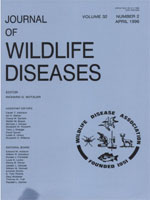The reservoir competence of the raccoon (Procyon lotor) for the Lyme disease spirochete (Borrelia burgdorferi) was evaluated in the laboratory during September 1991 to April 1993. Five raccoons were exposed to spirochete-infected (JD1 and Wisconsin 210 Wise strains) Ixodes scapularis nymphs (20/raccoon). A second feeding of spirochete-infected (Wisconsin 210 Wise strain) nymphs (20/raccoon) was performed with four of the original raccoons. Xenodiagnosis with cohorts of I. scapularis larvae (300/cohort) or nymphs (150/cohort) that were periodically placed on each animal was used to detect infection. We examined 1943 engorged ticks by a indirect immunofluorescence monoclonal antibody assay, but no spirochetes were detected. After exposure to spirochete-infected ticks, blood samples were collected at approximately weekly intervals and ear-skin biopsy samples were taken from each animal every third week. These tissues were placed in Barbour-Stoenner-Kelly media. Spirochetes were isolated in cultures of skin (wk 3, 5, 9, 81, and 83) and blood (wk 5, 8, 9, 11, and 12) of one raccoon and the skin (wk 28 and 31) of another raccoon. Antibody response of each animal was monitored through enzyme-linked immunosorbent assays and immunoblotting of blood serum against B. burgdorferi proteins. Except for one animal, raccoons did not have an antibody response until they were fed upon by a second cohort of infected I. scapularis nymphs. Based on Western blot analyses, raccoons exposed to B. burgdorferi via tick bite responded to the 31- (OspA) and 34-KDa (OspB) antigens. Response to other antigens varied among raccoons. Based on our results raccoons may be inefficient reservoirs for B. burgdorferi. Although some raccoons can become infected with B. burgdorferi, they may not transfer the infection to attached ticks.
How to translate text using browser tools
1 April 1996
EXPERIMENTAL INFECTION OF THE RACCOON (PROCYON LOTOR) WITH BORRELIA BURGDORFERI
Douglas E. Norris,
Jay F. Levine,
Monica Menard,
Kazuhide Nakagaki,
Peter Howard,
Charles S. Apperson

Journal of Wildlife Diseases
Vol. 32 • No. 2
April 1996
Vol. 32 • No. 2
April 1996
Borrelia burgdorferi
Ixodes scapularis
Lyme disease
Procyon lotor
raccoons




